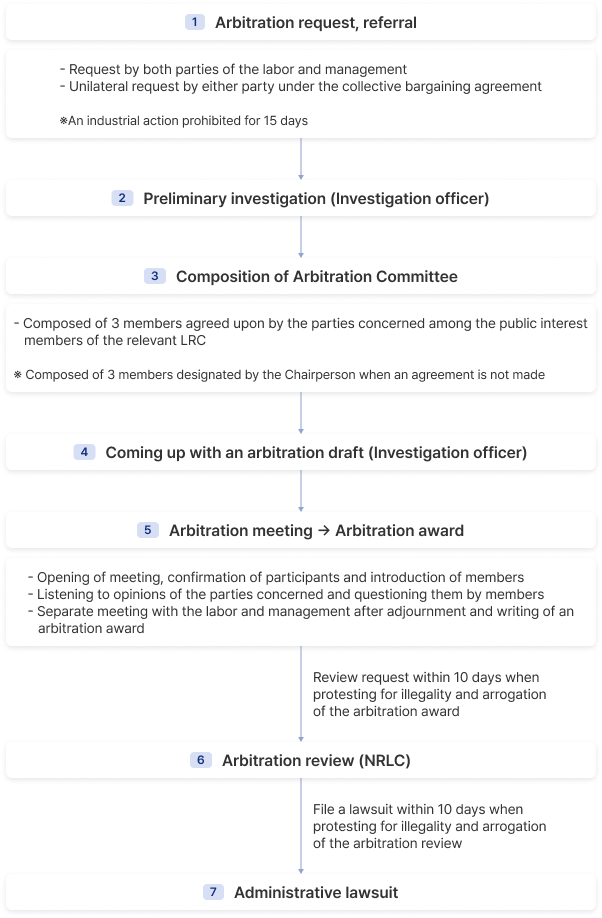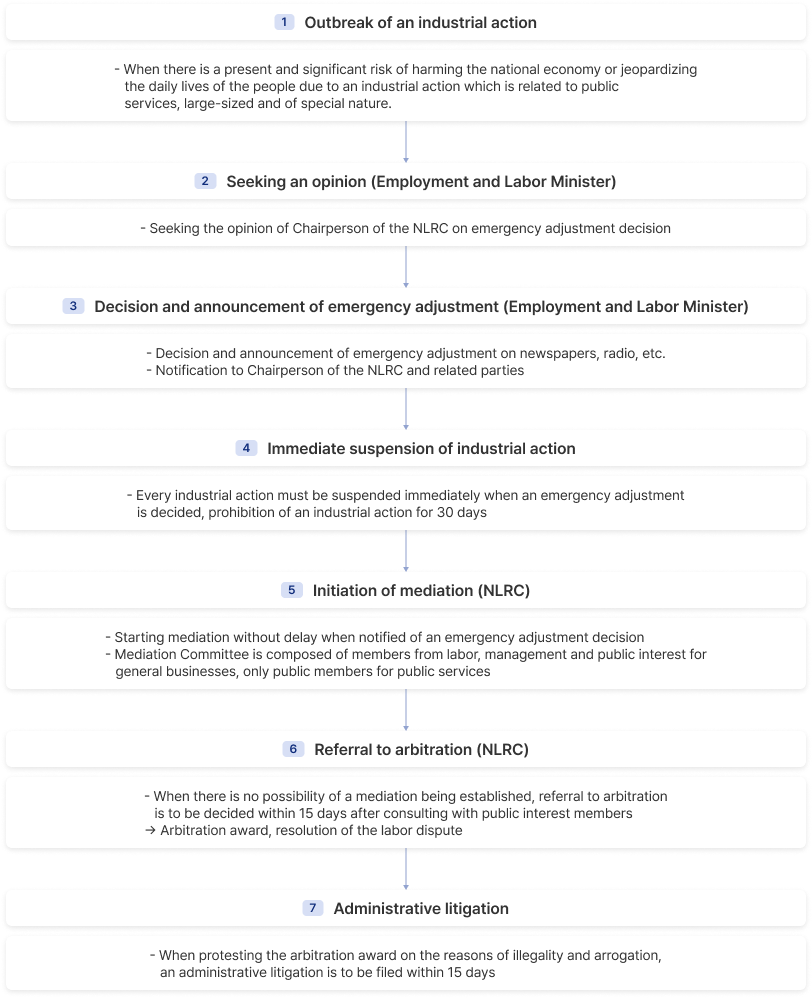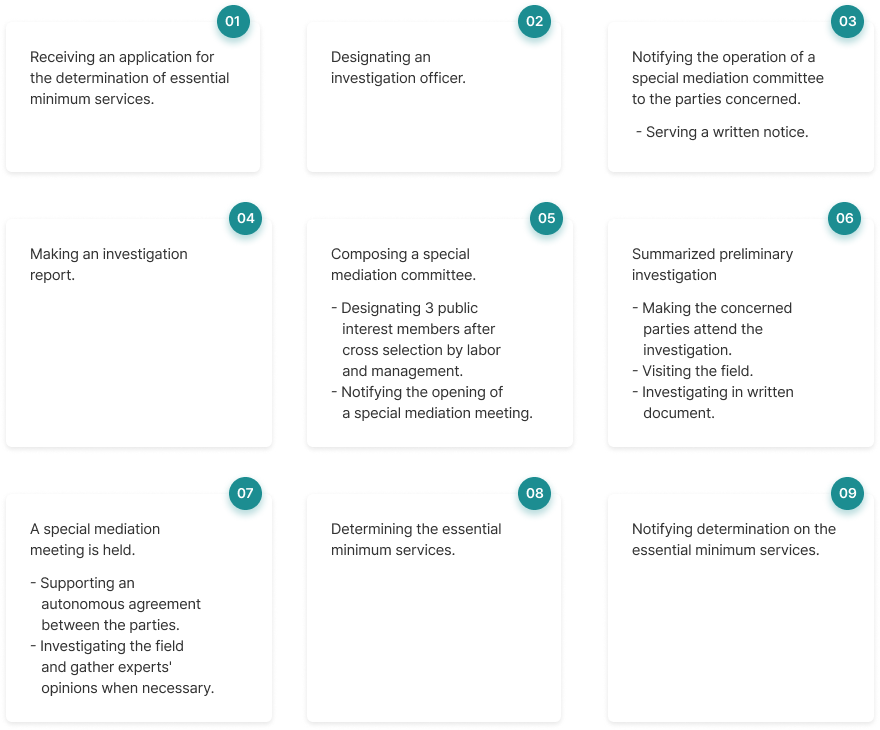Adjustment
Adjustment
In the Trade Union and Labor Relations Adjustment Act (TULRAA) enacted on December 31, 1996 (effective March 1, 1997), the so-called ‘rule of prior recourse to adjustment’ was stipulated. If a labor dispute arises due to failure of the bargaining between the labor and management parties, only after either party requests adjustment to the LRC and the adjustment of the LRC is carried out, then it becomes possible to wage an industrial action. Adjustment of labor disputes include: (1) mediation, in which the Mediation Committee which is established by the LRC on the request of either party produces a mediation proposal and recommends its acceptance to the parties concerned; (2) arbitration, which both the parties concerned apply for or either party applies for in accordance with their collective bargaining agreement; (3) emergency adjustment, which is rarely carried out only when an industrial action presents a risk of jeopardizing the national economy or people's daily lives. Regarding adjustment of labor disputes, conciliation, mediation, arbitration, emergency adjustment, etc. were formerly in place. However, when TULRAA was enacted in December 1996, conciliation and mediation were merged. Currently, mediation, arbitration and emergency adjustment are in place. In other words, there are mediation, arbitration and emergency adjustment as types of adjustment in labor disputes, and they are organically linked to each other. The overall flow of these functions is shown in Figure below.
Procedures of industrial action adjustment

Adjustment Committees
(1) Adjudication Committee
The Adjudication Committee is comprised of three persons nominated by the chairperson of the concerned LRC, from among the public interest members in charge of adjudication, and deals with matters related to the decisions, resolutions, approval, recognition, etc. under TULRAA, the LSA, the WPCA, or any other law (LRCA, Article 15, Para. 3). Those that fall into this category are: adjudication on the remedy request for unfair labor practices, procedures on establishing a single bargaining channel and determinations on the request for redress as well as objections raised, separation of bargaining units, orders to redress violation of fair representation duty of the representative bargaining union, proposing opinions on how to interpret and implement the collective bargaining agreement, adjudication on a remedy request for unfair dismissal, leave of absence, suspension from work, job transfer, wage cut and other disciplinary actions (hereinafter referred as “unfair dismissal, etc.”) by an employer, deciding to impose an enforcement levy when the concerned party does not comply with the remedy order in an unfair dismissal case, and so on (LRC Rules, Article 16). In addition to these, the Adjudication Committee may recommend a conciliation between the concerned parties, present a proposal of conciliation, or draw up a conciliation statement, if cases involving violation of the duty of fair representation and remedy request concerning unfair labor practices and unfair dismissal are brought to the Committee (LRCA, Article 16-3).
(2) Discrimination Redress Committee
This sectoral committee was newly established due to the legislation of the FPWPA and the revision of the TAWPA on December 21, 2006. The Discrimination Redress Committee (“DRC”) is comprised of three persons nominated by the chairperson of the relevant LRC, from among the public interest members in charge of discrimination redress, and deals with matters related to the discrimination redress under the FPWPA or the TAWPA (LRCA, Article 15, Para. 4). In greater detail, when the parties concerned directly apply for, or when the Minister of Employment and Labor notifies, the Committee deals with cases on discrimination redress, mediation and arbitration for fixed-term, part-time and agency workers (LRC Rules, Article 17).
(3) Mediation Committee
A Mediation Committee is installed in the LRC for the mediation of labor disputes (TULRAA, Article 55, Para. 1). The Mediation Committee members are nominated by the chairperson of the LRC from among the members of the relevant LRC so that each member may represent employers, workers, and the public interest. The member representing workers should be recommended by the employers’ association, and the member representing the employer should be recommended by labor unions. However, when either workers or employers fail to present a list of members three days prior to the opening of the Mediation Committee, the chairperson of the LRC may nominate the members (TULRAA, Article 55, Para. 3). The public interest member is nominated from among the public interest members in charge of mediation (LRCA, Article 15, Para. 5), and the public interest member becomes the chairperson of the Mediation Committee (LRCA, Article 56). The Mediation Committee mediates labor disputes of a general business and deals with issues regarding how to interpret or implement mediation proposals (LRC Rules, Article 18, Para. 1).
(4) Special Mediation Committee
The Special Mediation Committee (“SMC”) is established within the LRC for the mediation of labor disputes in public services (TULRAA, Article 72, Para. 1). The SMC members are comprised of three public interest members, who are nominated by the chairperson of the LRC. Prior to this process, the labor union and the employer choose four to six eligible candidates by taking turns in selecting them among the public interest members in charge of mediation. However, if labor and management recommend those who are not the members of the LRC by agreement, the chairperson of the LRC should nominate the recommended ones as the members of the SMC (TULRAA, Article 72). The chairperson of the SMC is elected from among the members of the SMC, who are public interest members of the LRC (TULRAA, Article 73). The SMC mediates labor disputes in public services, suggests opinions on how to interpret or implement mediation proposals, determines on which level the essential services should be maintained and operated, and deals with matters on how to interpret or implement the decision on the operation of the essential minimum services (LRC Rules, Article 18, Para. 2).
(5) Arbitration Committee
The LRC has an Arbitration Committee, which is composed of three members, for arbitration or review of labor disputes (TULRAA, Article 64, Para. 1, 2). Members of the Arbitration Committee are chosen by agreement between the parties concerned from among public interest members in charge of mediation, and appointed by the chairperson of the LRC. However, if the parties concerned fail to reach an agreement, the chairperson of the LRC nominates the Arbitration Committee members from among the public interest members in charge of mediation (TULRAA, Article 64, Para. 3). The chairperson of the Arbitration Committee is elected from among its members (TULRAA Article 65). The Arbitration Committee arbitrates labor disputes and deals with issues on how to interpret arbitration decisions or their execution (LRC Rules, Article 18, Para. 3).
Mediation
- Mediation is a process in which a neutral and impartial third party to a labor dispute becomes a mediator between labor-related parties and listens to the opinions of the labor and management sufficiently and understands their positions better in order to persuade them to reach an agreement. Mediation is a proactive approach, such as suggesting a solution (suggestion, recommendation or advice) to the parties of the dispute, as opposed to facilitating discussion to help them find a solution themselves. However, they are not required to accept the proposed solution. Besides such a general mediation, there is also a 'pre-mediation support system' that supports autonomous dispute resolution by the parties concerned, such as arranging negotiations for smooth mediation even before the request for mediation , and an ‘ex post facto mediation system’ that supports autonomous dispute resolution by the parties concerned, carrying out mediation after the end of the mediation period even when a mediation is not established within the statutory mediation period. In these cases, unlike ordinary mediation, there is no restriction on the mediation period, but a request or consent of both labor and management parties is required.
Mediation procedures

Arbitration
- Arbitration is a procedure in which both parties or either party to a labor dispute requests to the LRC in accordance with their collective bargaining agreement to settle it based on the disposition which is the arbitration award of the LRC. Arbitration is a disposition that is legally binding on the parties concerned, unlike mediation that is based on the principle of autonomous resolution between the labor and management. Acceptance of the arbitration statement is not entrusted to the will of labor and management parties and the parties concerned must comply with it. When a labor dispute is referred to arbitration, no industrial action can be taken for fifteen days from the referral date.
Arbitration procedures

Emergency adjustment
- Emergency adjustment is a system in which the Minister of Employment and Labor decides emergency adjustment for labor disputes, in consultation with the Chairperson of the NLRC, which are unsolved through normal mediation procedures of the LRC from a public interest point of view in order to suspend an industrial action and have the NLRC initiate mediation procedures to solve them. Emergency adjustment is an exceptional measure which is to be taken when a risk of jeopardizing the national economy or the daily lives of the people is present. When the NLRC is notified of an emergency decision from the Minister of Employment and Labor, it shall initiate adjustment without delay. Emergency adjustment is a series of urgent procedures; when it is judged that the national economy or the daily lives of the people are endangered by an industrial action. Emergency adjustment temporarily stops the action and solves the labor dispute that introduced it by means of the ex officio mediation or compulsory arbitration by the NLRC.
Emergency adjustment procedures

Private mediationt
- Mediation of labor disputes is usually subject to the public mediation procedures of the LRC, but they are not compulsory. Accordingly, the labor and management can receive private mediation or arbitration from a third party or organization other than the LRC either pursuant to an agreement between the parties or a collective bargaining agreement. As such, mediation other than one by the LRC - public mediation - is called ‘private mediation’. Labor and management parties can request mediation or arbitration to the LRC by an agreement between the parties concerned, even in the course of private mediation or arbitration. The current TULRAA acknowledges private or arbitrary mediation as a way for autonomous resolution. A method of mediation or arbitration that is different from the contents or the procedures. Labor and management parties can stipulate all the private adjustment procedures of mediation or arbitration together or only the procedures for one of the two. Therefore, the private mediation process can be organized into various forms according to the characteristics of each workplace. In addition, the private mediation procedures agreed upon by the parties concerned are understood as having priority over the public mediation procedures under TULRAA. This is called the 'principle of having a priority recourse to private mediation'. If labor and management parties decide to resolve a labor dispute in accordance with private mediation procedures, they must report it to the concerned LRC. As in the case of public mediation, a ten-day mediation period also applies to general businesses, and a fifteen-day period for public services. The prohibition of an industrial action during the mediation periods also applies. When a mediation or arbitration is established under private mediation procedures, its contents shall have the same effect as a collective bargaining agreement. Labor and management parties can resolve labor disputes through private mediation and arbitration even if public mediation is under way by the LRC. In this case, the period of mediation is to be counted anew from the date when the private mediation commenced. However, if labor disputes are not resolved by private mediation, both sides can request mediation and arbitration to the LRC in accordance with TULRAA. The period of mediation is counted anew from the date of the request to the LRC. As such, TULRAA allowed resolution of labor disputes by means of private mediation other than public mediation, according to a mutual agreement between the parties concerned. However, it was not widely uses as an infrastructure because support of private mediation were insufficient; for example, paying a fee for private mediator was illegal. With the amendment of TULRAA in December 2006, legal grounds were created to allow a private mediator or arbitrator to receive a fee, allowances and travel expenses from labor-related parties, thereby paving the way for the participation of professional and competent people in the activation of private mediation.
adjudication on the maintenance and operation levels of the essential minimum services
- The term essential minimum services means “businesses of which suspension or discontinuance may seriously endanger life, health or physical safety of the public or their daily lives, which is prescribed by Presidential Decree, among the essential public services . The parties to labor relations should conclude an agreement in writing that stipulates the necessary minimum level of maintenance and operation of the essential minimum services, targeted jobs, and the necessary number of workers, etc. in order to maintain and operate the essential minimum services during the period of industrial actions. In such cases, both parties to labor relations should sign and put seals on the agreement on the essential minimum services. This agreement is called Essential Minimum Service Agreement (EMSA). When the EMSA is not concluded, both parties or either party to labor relations should file a request to the LRC to determine the necessary minimum level of the maintenance and operation of the essential minimum services, targeted jobs, and the necessary number of workers. Upon receiving the request, the LRC may adjudicate on the above-mentioned items, taking into account the characteristics, job content, and so forth of each workplace for the essential minimum services.
Procedures to determine the maintenance and operation

